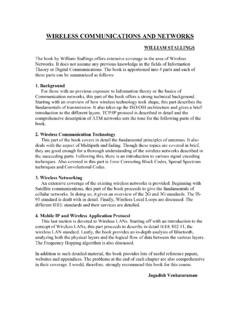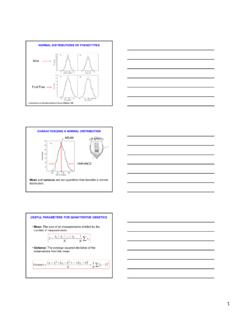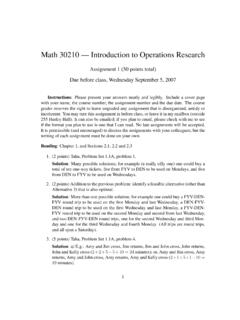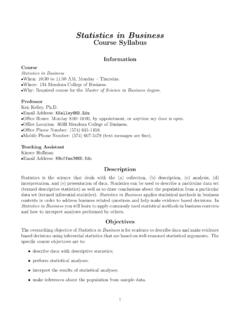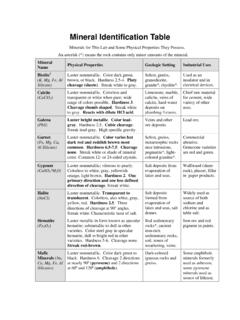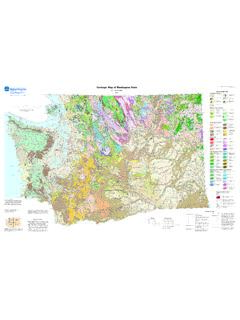Transcription of Chapter 22: Classification of Metamorphic Rocks
1 Prograde Metamorphism Prograde: increase in Metamorphic grade with time as a rock is subjected to gradually more severe conditions Prograde metamorphism: changes in a rock that accompany increasing Metamorphic grade Retrograde:decreasing grade as rock cools and recovers from a Metamorphic or igneous event Retrograde metamorphism: any accompanying changes1 The Progressive Nature of MetamorphismA rock at a high Metamorphic grade probably progressedthrough a sequence of mineral assemblages rather than hopping directly from an unmetamorphosed rock to the Metamorphic rock that we find today2 The Progressive Nature of MetamorphismRetrogrademetamorphism typically of minor significance Prograde reactions are endothermic and easily driven by increasing T Devolatilization reactions are easier than reintroducing the volatiles Geothermometry indicates that the mineral compositions commonly preserve the maximum temperature 3 Types of ProtolithLump the common types of sedimentary and igneous Rocks into six chemically -very high Mg, Fe, Ni, -high Fe, Mg, and (pelitic)
2 -high Al, K, -high Ca, Mg, -nearly pure -high Si, Na, K, Al4 Some Examples of Metamorphism Why study Metamorphic regions/areas? Interpretation of the conditions and evolution of Metamorphic bodies, mountain belts, and ultimately the state and evolution of the Earth's crust Metamorphic Rocks may retain enough inherited information from their protolith to allow us to interpret much of the pre- Metamorphic history as well5 Orogenic Regional Metamorphism of the Scottish Highlands George Barrow (1893, 1912) SE Highlands of Scotland -Caledonian Orogeny~ 500 Ma Nappes series of intensely folded Rocks Granites6 Barrow s AreaFigure Regional Metamorphic map of the Scottish Highlands, showing the zones of minerals that develop with increasing Metamorphic grade. From Gillen (1982) Metamorphic Geology.
3 An Introduction to Tectonic and Metamorphic Processes. George Allen & Unwin. London. 7 Orogenic Regional Metamorphism of the Scottish Highlands Barrow studied the peliticrocks Could subdivide the area into a series of Metamorphic zones, each based on the appearance of a new mineral as Metamorphic grade increased8 The sequence of zones now recognized, and the typical Metamorphic mineral assemblage in each, are: Chlorite zone. Pelitic Rocks are slates or phyllites and typically contain chlorite, muscovite, quartz and albite Biotite zone. Slates give way to phyllites and schists, with biotite, chlorite, muscovite, quartz, and albite Garnet zone. Schists with conspicuous red almandine garnet, usually with biotite, chlorite, muscovite, quartz, and albite or oligoclase Staurolite zone. Schists with staurolite, biotite, muscovite, quartz, garnet, and plagioclase.
4 Some chlorite may persist Kyanite zone. Schists with kyanite, biotite, muscovite, quartz, plagioclase, and usually garnet and staurolite Sillimanite zone. Schists and gneisses with sillimanite, biotite, muscovite, uartz, plagioclase, garnet, and perhaps staurolite. Some kyanite may also be present (although kyanite and sillimanite are both polymorphs of Al2 SiO5)9 Sequence = Barrovian zones The P-T conditions referred to as Barrovian-type metamorphism(fairly typical of many belts) Now extended to a much larger area of the Highlands Isograd= line that separates the zones (a line in the field of constant Metamorphic grade)10 Figure Metamorphic map of the Scottish Highlands, showing the zones of minerals that develop with increasing Metamorphic grade. From Gillen (1982) Metamorphic Geology.
5 An Introduction to Tectonic and Metamorphic Processes. George Allen & Unwin. London. 11To summarize: An isogradrepresents the first appearance of a particular Metamorphic index mineral in the field as one progresses upmetamorphic grade When one crosses an isograd, such as the biotite isograd, one enters the biotite zone Zones thus have the same name as the isograd that forms the low-gradeboundary of that zone Because classic isograds are based on the first appearance of a mineral, and not its disappearance, an index mineral may still be stable in higher grade zones12A variation occurs in the area just to the north of Barrow s, in the Banff and Buchandistrict Pelitic compositions are similar, but the sequence of isograds is: chlorite biotite cordierite andalusite sillimanite13 The stability field of andalusite occurs at pressures less than GPa (~ 10 km), while kyanite sillimanite at the sillimanite isograd only above this pressureFigure The P-T phase diagram for the system Al2 SiO5showing the stability fields for the three polymorphs andalusite, kyanite, and sillimanite.
6 Also shown is the hydration of Al2 SiO5to pyrophyllite, which limits the occurrence of an Al2 SiO5polymorph at low grades in the presence of excess silica and water. The diagram was calculated using the program TWQ (Berman, 1988, 1990, 1991). 14 Paired Metamorphic Belts of JapanFigure Sanbagawa and Ryoke Metamorphic belts of Japan. From Turner (1981) Metamorphic Petrology: Mineralogical, Field, and Tectonic Aspects. McGraw-Hill and Miyashiro (1994) Metamorphic Petrology. Oxford University Press. 15 Paired Metamorphic Belts of Japan16 Figure of the paired Metamorphic belts in the circum-Pacific region. From Miyashiro (1994) Metamorphic Petrology. Oxford University Press. 17 Chapter 22: A Classification of Metamorphic Rocks Metamorphic Rocks are classified on the basis of textureand composition(either mineralogical or chemical) Unlike igneous Rocks , which have been plagued by a proliferation of local and specific names, Metamorphic rock names are surprisingly simple and flexible May choose some prefix-type modifiers to attach to names if care to stress some important or unusualtextural or mineralogical aspects18 FoliatedMetamorphic Rocks Foliation:any planar fabric element Lineation:any linear fabric elements They have no genetic connotations Some high-strain Rocks may be foliated, but they are treated separately19 FoliatedMetamorphic RocksCleavage Traditionally.
7 The property of a rock to split along a regular set of sub-parallel, closely-spaced planes A more general concept adopted by some geologists is to consider cleavage to be any type of foliation in which the aligned platy phyllosilicates are too fine grained to see individually with the unaided eye 20 FoliatedMetamorphic RocksSchistosity A preferred orientation of inequaint mineral grains or grain aggregates produced by Metamorphic processes Aligned minerals are coarse grained enough to see with the unaided eye The orientation is generally planar, but linear orientations are not excluded 21 FoliatedMetamorphic RocksGneissosestructure Either a poorly-developed schistosity or segregated into layers by Metamorphic processes Gneissose Rocks are generally coarse grained 22 Figure Examples of foliated Metamorphic Rocks .
8 A. Slate. b. Phyllite. Note the difference in reflectance on the foliation surfaces between a and b: phyllite is characterized by a satiny sheen. Winter (2001) An Introduction to igneous and Metamorphic Petrology. Prentice : Slateb: PhylliteSlate: compact, very fine-grained, Metamorphic rock with a well-developed cleavage. Freshly cleaved surfaces are dull Phyllite: a rock with a schistosity in which very fine phyllosilicates (sericite/phengite and/or chlorite), although rarely coarse enough to see unaided, impart a silky sheen to the foliation surface. Phyllites with both a foliation and lineation are very common. FoliatedMetamorphic Rocks23 Figure muscovite schist. Muscovite crystals are visible and silvery, garnets occur as large dark porphyroblasts. Winter (2001) An Introduction to igneous and Metamorphic Petrology.
9 Prentice : a Metamorphic rock exhibiting a schistosity. By this definition schist is a broad term, and slates and phyllites are also types of schists. In common usage, schists are restricted to those Metamorphic Rocks in which the foliated minerals are coarse enough to see easily in hand specimen. FoliatedMetamorphic Rocks24 Figure gneiss with obvious layering. Winter (2001) An Introduction to igneous and Metamorphic Petrology. Prentice : a Metamorphic rock displaying gneissose structure. Gneisses are typically layered (also called banded), generally with alternating felsic and darker mineral layers. Gneisses may also be lineated, but must also show segregations of felsic-mineral-rich and dark-mineral-rich concentrations. FoliatedMetamorphic Rocks25 Non-FoliatedMetamorphic RocksSimpler than for foliated rocksAgain, this discussion and Classification applies only to Rocks that are not produced by high-strain metamorphismGranofels: a comprehensive term for any isotropic rock (a rock with no preferred orientation)Hornfelsis a type of granofels that is typically very fine-grained and compact, and occurs in contact aureoles.
10 Hornfelses are tough, and tend to splinter when broken. 26 Specific Metamorphic Rock TypesMarble: a Metamorphic rock composed predominantly of calcite or dolomite. The protolith is typically limestone or : a Metamorphic rock composed predominantly of quartz. The protolith is typically sandstone. 27 Greenschist/Greenstone: a low-grade Metamorphic rock that typically contains chlorite, actinolite, epidote, and albite. Note that the first three minerals are green, which imparts the color to the rock. Such a rock is called greenschist if foliated, and greenstone if not. The protolith is either a mafic igneous rock or : a Metamorphic rock dominated by hornblende (amphibole) + plagioclase. Amphibolites may be foliated or non-foliated. The protolith is either a mafic igneous rock or Metamorphic Rock Types28 Specific Metamorphic Rock TypesSerpentinite: an ultramafic rock metamorphosed at low grade, so that it contains mostly :a blue amphibole (glaucophane)-bearing metamorphosed mafic igneous rock or mafic graywacke.
